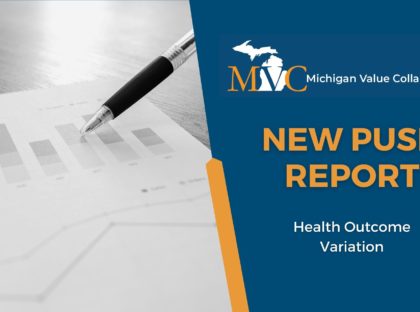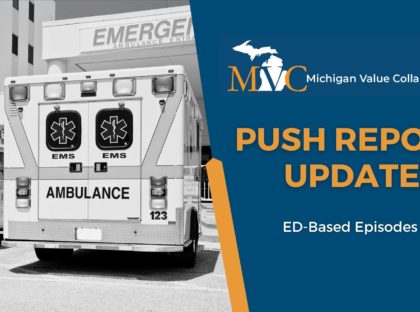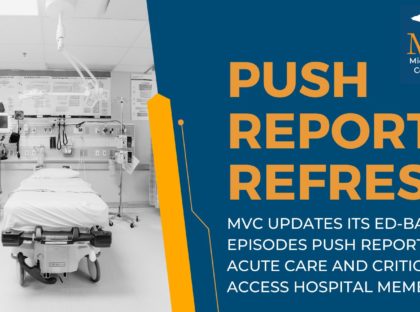On Monday, the Coordinating Center distributed a refreshed version of MVC’s common conditions report. This report delivers a comprehensive analysis of care episodes for eight prevalent medical and surgical conditions, frequently targeted for quality improvement initiatives within MVC hospitals. It assesses hospital performance and highlights potential areas for growth. The report’s current conditions include chronic obstructive pulmonary disease (COPD), colectomy (non-cancer), congestive heart failure (CHF), total knee and hip (joint) replacement, percutaneous coronary intervention (PCI), pneumonia, and sepsis. Notably, acute myocardial infarction (AMI) and spine surgery, which were previously included, have been replaced by two new conditions, PCI and sepsis, in the latest report.
MVC generated reports for 96 eligible hospitals. General acute care hospital and Critical Access Hospital (CAH) members received tailored versions of the report, which included benchmark data specific to their respective hospital categories and tailored comparison groups.
Although the provided metrics vary by condition and case count, report pages generally focus on 30-day total episode payments, post-acute care and post-discharge ED utilization, readmission rates, and common reasons for readmissions. MVC price standardizes total episode payments to Medicare FFS amounts so that comparisons can be made across hospitals over time. Payments are risk-adjusted for patient age, gender, payer, comorbidities, and high or low prior healthcare utilization/payments.
The report has been updated to feature recent data covering the period of January 1, 2022, through December 31, 2023, for Blue Cross Blue Shield of Michigan (BCBSM) / Blue Care Network (BCN) Commercial, BCBSM/BCN Medicare Advantage (MA), and Michigan Medicaid; Medicare FFS data covers the period of January 1, 2022, through November 30, 2022.
Upon opening the latest report, MVC members will find the integration of a “Common Conditions and Procedures Report”, which consolidates the patient population data for all conditions at each hospital, facilitating a more comprehensive and effective comparison.
Additionally, each page now features a figure displaying the breakdown of 30-day risk-adjusted, price-standardized post-acute care payments by new payer categories (See Figure 1). The new categories include BCBSM/BCN Commercial, BCBSM/BCN Medicare Advantage, Medicare Only, Medicaid Only, and Dual Eligible. With the addition of the “Dual-Eligible” category, it should be emphasized that dual-eligible patients have been reclassified as such and are now exclusively represented within this new category and no longer represented in the separate Medicare and Medicaid categories.
Beyond offering insights into payments by payer and post-acute care categories, this figure gains significant value when analyzed alongside the new graphical representation of post-acute care utilization rates (See Figure 2). This comparative analysis serves to clarify the spending trends associated with each post-acute care category, illustrating how spending aligns with utilization frequency. The updated dot figure now features expanded post-acute care categories, with the addition of Inpatient Rehabilitation (IP Rehab), Outpatient Rehabilitation (OP Rehab), Emergency Department (ED), and Long-Term Acute Care Hospital (LTACH) services. This figure also depicts the percentage of each hospital’s patients who utilized home health care, skilled nursing facility (SNF) care, and outpatient services.
Across the collaborative, reports continue to show high use of 30-day home health care and outpatient services for these common conditions. For patients initiating their episode of care at a general acute care hospital within the collaborative, the home health care utilization rate was highest following CABG and joint replacement.
Patients experiencing a CABG episode were noted to have significant use of outpatient services within the 30 days following the index event, demonstrating an average utilization rate of 66%. This rate reflects a 7% decline in utilization rate from the figures reported in the previous common conditions report. Patients with episodes of CHF and PCI were also high utilizers of outpatient services.
One final trend noted across the collaborative is a general decrease in 30-day readmission rates for colectomy, COPD, CABG, CHF, pneumonia, and sepsis (See Figure 3).
MVC is dedicated to regularly updating its commons conditions report, aiming to equip collaborative partners with insightful data that can drive and reinforce meaningful advancements in healthcare quality. We hope these reports prove beneficial and welcome MVC members to contact MVC with any questions or analytic requests.







